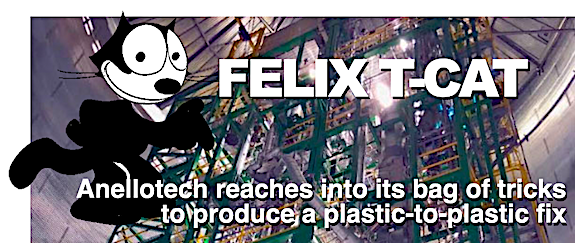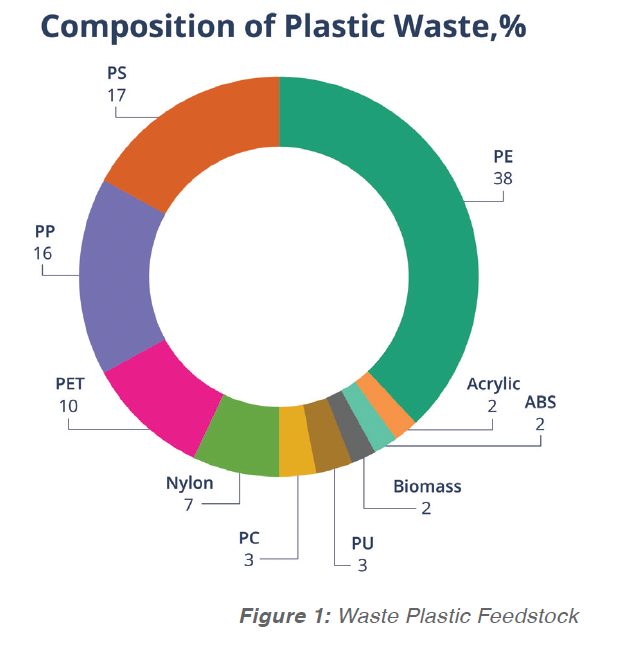Felix T-Cat: Anellotech reaches into its bag of tricks to produce a plastic-to-plastic fix

Happy news has arrived from Pearl River, New York and the R&D team at Anellotech. It’s not so long ago that we were hailing the Pearl River development of a COVID vaccine by the Pfizer-BioNTech collab. Seems like we may need to re-name this part of the world “Happy River”. This latest discovery from Anellotech is a sort of vaccine all its own, a technology that, when commercialized, will help the world solve the disease of single-use plastics. Too many people are focused on figuing out ways to eliminate, for example, clear plastic bottles and clear plastic wrap, despite their enormous functional benefits, because of the waste propblem, which is a problem and a big one.
Anellotech has developed Plast-TCat technology to address the gap. Now, we have news that Anellotech has, for the first time, continuously processed solid, post-consumer plastic waste into light olefins and aromatics using its Plas-TCat catalytic pyrolysis technology. The waste consisted of a mixture of all major plastic types, with the exception of polyvinyl chloride (PVC).
Completing the Circle
It’s full circularity. Here’s how.
 The processing trial took place at Anellotech’s TCat- 8TM fully automated, 30 meter tall pilot plant near Houston, Texas (Figure 2, video here). That plant’s nameplate capacity is 0.5 tons per day, and Plas-TCat’s scalable fluidized bed reactor design provides a path to larger commercial production plants capable of addressing substantial global recycling goals. Plas-TCat employs one thermal catalytic reactor to convert a broad range of mixed waste plastics into the same valuable chemical feedstocks used today to make virgin plastics.
The processing trial took place at Anellotech’s TCat- 8TM fully automated, 30 meter tall pilot plant near Houston, Texas (Figure 2, video here). That plant’s nameplate capacity is 0.5 tons per day, and Plas-TCat’s scalable fluidized bed reactor design provides a path to larger commercial production plants capable of addressing substantial global recycling goals. Plas-TCat employs one thermal catalytic reactor to convert a broad range of mixed waste plastics into the same valuable chemical feedstocks used today to make virgin plastics.
These include benzene, toluene and xylene (BTX) as well as ethylene, propylene and butylene (light olefins). Based on a proprietary catalyst and fluid bed reactor-regenerator system, Plas-TCat provides a new, direct route to light olefins and aromatics from heterogeneous plastic waste streams—without the need for steam cracker furnaces. The technology can effectively process a wide range of waste plastics, alone or within composites. This includes polyolefins, polyamides (nylon), PET, polycarbonate and polystyrene. With the completion of these continuous process runs Plas-TCat is now at Technology Readiness Level (“TRL”) 6.
Better than that, this is not a mevhanical recycling of plastics, with structural flaws and weaknesses. This is re-virginized plastic.
What exactly are the targets?
Anellotech shared some fascinating data they gathered on major PET-using brand owners like Coca-Cola, Keurig Dr. Pepper and Pepsico as well as textile recycling brands like H&M and Levi’s. Here’s are some highlights of what they found so far:
- The Coca-Cola Company – Their aim is to collect and recycle a bottle or can for every one sold by 2030, aim to reduce the carbon footprint of “the drink in your hand” by 25% by 2020, make their global packaging 100% recyclable by 2025.
- Pepsico – Design 100% of packaging to be recyclable, compostable or biodegradable by 2025, increase recycled content in plastics packaging to 25% by 2025, Reduce 35% of virgin plastic use across beverage portfolio by 2025.
- Keurig Dr. Pepper – Aim to close the loop across all of their packaging materials by ensuring 100% recyclability or composability and using 30% recycled material across portfolio by 2025, aim to send zero waste to landfill across operations by 2025.
- H&M – While a majority of H&M stores already offer in-store garment collecting, their goal is to be able to reuse and recycle all textile fibers, by 2030 to have 100% recycled or other sustainably sourced materials and by 2040 to have a climate positive value chain.
- Levi Strauss & Co. – Current actions include collecting used clothing and recycling it with a goal to design more and more products that are suitable for true circularity with 100% recyclable materials from the outset.
The Bottom Line
Aficionados of The Cartoon Channel or other outlets will remember Felix the Cat and his Magic Bag that he reached into whenever he needed a miraculous turn of fortune. So, Felix T-Cat, one supposes, is the right metaphor for this story. In our case, the fix we’re in is not how to recover plastic but how to re-virginize it into original molecules that the chemical industry actually uses. Like ethylene, propylene, benzene, toluene and xylene, five of the fundamental chemicals from which all the finer chemicals are made (along with methanol and, er, butadiene if memory serves).
You’re in fix unless you can remake the Big Six, that’s the bottom line. Biodegradable plastics are alright, but until we have alternatives with comparable barrier properties and flexibility of handling, not to mention price, we’re likely to have plastics. Hence, the need and thirst for this solution. Making this a pretty big deal.
There’s another thing. We sure like Anellotech, it’s the molecules and a lot mroe, to paraphrase an old Oly beer ad. There’s just a sort of refusal to go away, to be discouraged or dismayed by the attention given to others, or the calls to inaction or loss of faith that the economy always doles out to start-up. Reminds us of the old Felix the Cat song from the 1920s, not the kiddie song from the 1950a:
Felix kept on walking, kept on walking still.
Someone tried to drown him, with a brick tied round him.
Shoved him in the rain-tub there, but him they couldn’t kill,
Started lapping with his tongue
Till that water all was done
Then he crept out through the “bung” and kept on walking still.
The Multi-Slide Guide
Game-changing Plastic Trash to Treasure: The Digest’s 2022 Multi-Slide Guide to Anellotech
The Anellotech backstory
First, what is Anellotech? It’s a tech company focused on commercializing production of cost-competitive renewable chemicals and fuels from non-food biomass or waste plastics. Its patented Bio-TCat technology is a thermal catalytic process for converting biomass into benzene, toluene and xylene, which are chemically identical to petroleum-based counterparts. Itr was part of leveraging the Bio-TCat platform for Plas-TCat, a process technology aiming to convert mixed waste plastics into commodity chemicals such as olefins and aromatics.
From the same mixed plastic feedstock, the new process can be adjusted to two different production modes: ‘Hi-Olefins’ which emphasizes the production of olefins such as ethylene and propylene or ‘Hi-BTX’ which will produce mostly aromatics like BTX (benzene, toluene and xylene) and paraxylene – the key component needed for PET.
Back in 2020, we reported that Anellotech converted a Lay’s Barbeque Potato Chip bag into para-xylene, the primary chemical used to make virgin PET for beverage bottles, all by using its Plas-TCat Catalytic Pyrolysis technology which transforms mixed plastic waste directly into chemicals. The conversion also had high yields of benzene, toluene and olefins used to make a range of plastics, including polyethylene, polypropylene, nylon, ABS and polycarbonate.
According to CEO David Sudolsky, “Our unique approach features an economical zeolite catalyst and heat in one fluid bed reactor to make commodity chemicals directly from plastic waste. Contrast this with companies making pyrolysis oils from plastics which must be upgraded at a chemical plant. By leveraging our lab and TCat-8 pilot systems we are on track with Plas-TCat technology, solving two major problems at once – expanded rPET supply and efficient, large-scale recycling of single use packaging (including PE, PP and multilayer films). In addition, we are producing the same chemicals used today to make most major plastics.”
Reaction from the stakeholders
“Plas-TCat is advantageous due to its high olefin and aromatic hydrocarbon selectivity, high scalability, broad feedstock tolerance, as well as its substantial carbon dioxide emissions savings compared to industrial steam crackers,” says David Sudolsky, President and CEO of Anellotech. “The TCat-8 unit will be used in future month-long 24/7 trials to prove the robustness of the process and generate process performance data over an equilibrated catalyst, which are required to design a commercial plant.”
More on the story at the Anellotech site, here.
Category: Top Stories















